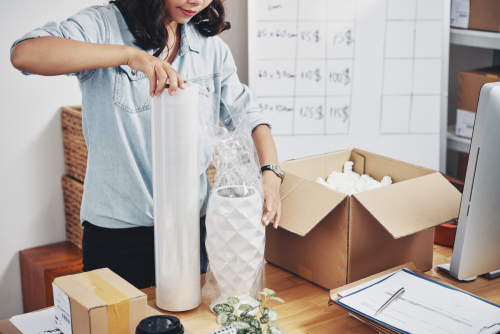
Packing fragile items for a move can feel like an overwhelming task. These items often hold sentimental or monetary value, making their safe transportation a top priority. Whether you’re dealing with glassware, electronics, or heirlooms, the key to success lies in preparation, technique, and the right materials. This guide will walk you through everything you need to know to pack fragile items safely and securely.
1. Assemble Your Packing Supplies
Before you start packing, ensure you have all the necessary materials. High-quality packing supplies are essential for protecting fragile items during transit. Here’s what you’ll need:
- Sturdy boxes: Choose a variety of sizes and opt for double-walled boxes for added durability.
- Packing paper: Acid-free paper is ideal for wrapping delicate items.
- Bubble wrap: Use it for cushioning items and wrapping particularly fragile pieces.
- Foam sheets: Great for layering between items or lining boxes.
- Packing peanuts: Fill empty spaces in boxes to prevent movement.
- Tape: Use strong packing tape to seal boxes securely.
- Labels and markers: Clearly label boxes containing fragile items for easy identification.
- Scissors or box cutters: For cutting tape and other packing materials.
Pro Tip: Reuse materials like newspapers or old towels as eco-friendly alternatives for padding.
2. Declutter Before You Begin
Moving is the perfect time to declutter your belongings. Take a moment to evaluate your fragile items and decide what’s worth keeping. This can save space and reduce stress:
- Donate or sell items you no longer need or use.
- Recycle or dispose of items that are damaged beyond repair.
By focusing on what truly matters, you’ll have fewer items to pack and a more organized move.
3. Create a Dedicated Packing Area
Set up a designated area for packing your fragile items. Choose a flat, clean surface like a dining table or large countertop. Keep your packing supplies within easy reach and ensure there’s plenty of room to work comfortably.
4. Wrap Each Item Individually
Wrapping fragile items individually is crucial to avoid scratches, chips, or breakage. Follow these steps:
- Start with packing paper: Place the item in the center of the paper and wrap it snugly, securing it with tape.
- Add a layer of bubble wrap: Wrap the item again with bubble wrap for extra cushioning, focusing on corners and edges.
- Use foam sheets for added protection: If the item is particularly delicate, consider adding a foam layer.
Examples:
- For glassware: Stuff the inside with packing paper before wrapping the exterior.
- For plates: Wrap each plate individually and stack them vertically with padding between them.
5. Pack Strategically
The way you arrange items in a box can significantly impact their safety. Here’s how to do it:
- Line the box: Start with a thick layer of packing material, such as crumpled paper or foam sheets, at the bottom of the box.
- Place heavier items first: This creates a stable base and prevents lighter items from being crushed.
- Avoid empty spaces: Fill gaps with packing peanuts or crumpled paper to prevent items from shifting during transit.
- Layer carefully: Place heavier, sturdier items at the bottom and more delicate items on top, separating layers with padding.
- Leave space for a top layer: Add one final protective layer before sealing the box.
6. Seal and Label Boxes
Once you’ve packed a box, it’s time to seal and label it. Proper labeling ensures that movers (or you) handle the box with care.
- Seal securely: Use high-quality packing tape to seal all edges of the box.
- Label clearly: Write “FRAGILE” and “THIS SIDE UP” on multiple sides of the box. Include a brief description of the contents, such as “Glassware” or “Electronics.”

7. Special Packing Tips for Common Fragile Items
a. Glassware and Stemware
- Wrap each piece individually with packing paper and bubble wrap.
- Use dividers inside the box to keep items from touching.
b. Plates and Dishes
- Wrap each plate in packing paper and bubble wrap.
- Stack plates vertically in the box to reduce the risk of breaking.
- Add cardboard dividers for extra protection.
c. Mirrors and Picture Frames
- Apply painter’s tape in an “X” shape across the glass to minimize shattering.
- Wrap the item in bubble wrap and place it in a specialized mirror box.
d. Electronics
- If possible, use the original packaging.
- Wrap devices in anti-static bubble wrap and secure cords separately.
- Fill empty spaces in the box with packing peanuts to prevent movement.
e. Lamps
- Remove lampshades and bulbs. Wrap each part separately in bubble wrap.
- Pack the lamp base and shade in different boxes if possible.
f. Fine China and Antiques
- Use foam sheets or bubble wrap to protect delicate surfaces.
- Place items in double-walled boxes for added security.
8. Transporting Fragile Items
When loading boxes containing fragile items, follow these guidelines:
- Place on top: Keep fragile boxes on top of heavier ones to prevent crushing.
- Secure in place: Use straps or padding to keep boxes from shifting during transit.
- Avoid stacking too high: Limit the number of boxes stacked to avoid toppling.
If possible, transport particularly valuable or sentimental items in your personal vehicle for added peace of mind.
9. Unpacking Fragile Items
The unpacking process is just as important as packing. Here’s how to do it carefully:
- Work in a clean space: Clear an area where you can safely unpack.
- Unpack one box at a time: Focus on one box to avoid accidentally damaging items.
- Inspect for damage: Check each item as you unpack it and report any issues if you used a moving company.
- Recycle materials: Save packing materials for future use or dispose of them responsibly.
10. The Value of Professional Packing Services
If you’re short on time or concerned about properly packing fragile items, professional movers can help. Many moving companies offer packing services, ensuring your valuables are handled with care.
Benefits of professional packing services:
- Expertise in handling delicate and valuable items.
- Access to high-quality materials and specialized packing techniques.
- Time-saving convenience, especially for large or complex moves.
11. Common Mistakes to Avoid
- Using low-quality materials: Invest in sturdy boxes and protective padding.
- Overloading boxes: Keep box weight manageable to prevent crushing.
- Leaving empty spaces: Fill gaps to prevent items from shifting.
- Rushing the process: Take your time to ensure each item is securely packed.
- Ignoring labels: Clearly label all boxes containing fragile items.
Final Thoughts
Packing fragile items doesn’t have to be daunting. With the right supplies, techniques, and a bit of patience, you can protect your valuables and ensure they arrive at your new home in perfect condition. By following this comprehensive guide, you’ll be well-prepared to tackle the challenge of moving fragile items.
Remember, preparation is key. Start early, stay organized, and don’t hesitate to seek professional help if needed. Happy moving!
Ready to Make Your Move Stress-Free?
Whether you’re relocating across town or across the country, Cord Moving and Storage is here to help! As one of the trusted St. Louis moving companies, we specialize in seamless transitions for both local and long-distance moves.
✅ Expert St. Louis local movers for hassle-free in-town moves
✅ Reliable St. Louis long-distance movers for cross-country adventures
✅ Professional packing, storage, and moving services tailored to your needs
Call us today at (636) 541-0707 or visit our website to get a free moving quote! Don’t wait—let’s make your move effortless.
Cord Moving and Storage: Moving You Forward!

